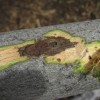 Thousand cankers disease of walnut is a tree disease of the edible nut-producing and ornamental tree, black walnut. The first diseased trees were observed in New Mexico in the 1990s. The disease has since spread to most of the western states. Until 2009, diseased black walnut trees were only found outside of the natural range of black walnut, which occurs from the mid-Atlantic states to just west of the Mississippi River. In 2009, it was found near Knoxville, Tennessee; it has since spread to Pennsylvania and Virginia. It is possible that within the next decade this disease could naturally spread to Florida. However, if people continue to move TCD infested walnut logs from place to place, this disease could arrive in Florida tomorrow. This 3-page fact sheet was written by Don Spence and Jason A. Smith, and published by the UF Department of School of Forest Resources and Conservation, February 2013.
Thousand cankers disease of walnut is a tree disease of the edible nut-producing and ornamental tree, black walnut. The first diseased trees were observed in New Mexico in the 1990s. The disease has since spread to most of the western states. Until 2009, diseased black walnut trees were only found outside of the natural range of black walnut, which occurs from the mid-Atlantic states to just west of the Mississippi River. In 2009, it was found near Knoxville, Tennessee; it has since spread to Pennsylvania and Virginia. It is possible that within the next decade this disease could naturally spread to Florida. However, if people continue to move TCD infested walnut logs from place to place, this disease could arrive in Florida tomorrow. This 3-page fact sheet was written by Don Spence and Jason A. Smith, and published by the UF Department of School of Forest Resources and Conservation, February 2013.
http://edis.ifas.ufl.edu/fr376
Tag: Donald Spence
Assessing the Survival of the Redbay Ambrosia Beetle and Laurel Wilt Pathogen in Wood Chips (FOR289/FR351)
 What is the best way for homeowners to dispose of dead redbay trees to avoid spreading laurel wilt? This 4-page fact sheet summarizes a UF/IFAS study providing evidence that a simple technique — chipping the dead trees — can help contain the disease within a small area and that there is a low probability of long-distance movement of LW via wood chips. Written by Don Spence, Jason Smith, Albert Mayfield III, Jiri Huler, Randy Ploetz and Lukasz Stelinski, and published by the UF Department of School of Forest Resources and Conservation, November 2011.
What is the best way for homeowners to dispose of dead redbay trees to avoid spreading laurel wilt? This 4-page fact sheet summarizes a UF/IFAS study providing evidence that a simple technique — chipping the dead trees — can help contain the disease within a small area and that there is a low probability of long-distance movement of LW via wood chips. Written by Don Spence, Jason Smith, Albert Mayfield III, Jiri Huler, Randy Ploetz and Lukasz Stelinski, and published by the UF Department of School of Forest Resources and Conservation, November 2011.
http://edis.ifas.ufl.edu/fr351
Emerald Ash Borer: A Potential Future Threat to Ash Trees in Florida (FOR284/FR346)
 Do not move firewood into or around the state! This invasive exotic beetle kills ash trees and is likely to reach Florida in the years to come — or faster if it gets transported by humans. Learn more in this 5-page fact sheet was written by Don Spence and Jason Smith, and published by the UF Department of School of Forest Resources and Conservation, August 2011.
Do not move firewood into or around the state! This invasive exotic beetle kills ash trees and is likely to reach Florida in the years to come — or faster if it gets transported by humans. Learn more in this 5-page fact sheet was written by Don Spence and Jason Smith, and published by the UF Department of School of Forest Resources and Conservation, August 2011.
http://edis.ifas.ufl.edu/fr346
EENY470/IN857 A tiphiid wasp Myzinum maculata Fabricius (Insecta:Hymenoptera:Tiphiidae:Myzininae)
EENY470, a 5-page illustrated fact sheet by Donald Spence and Amanda Hodges, is part of the Featured Creatures collection. It describes this wasp species commonly found in Florida — distribution, description, life cycle, hosts, and economic importance. Includes references. Published by the UF Department of Entomology and Nematology, June 2010.
http://edis.ifas.ufl.edu/in857